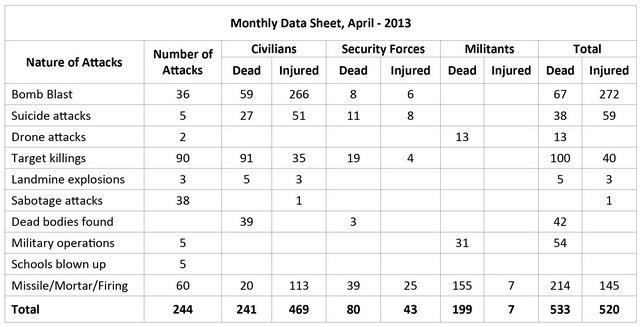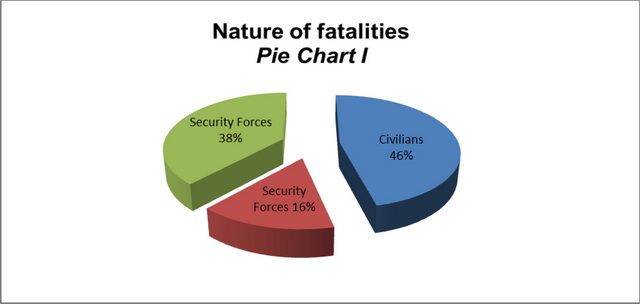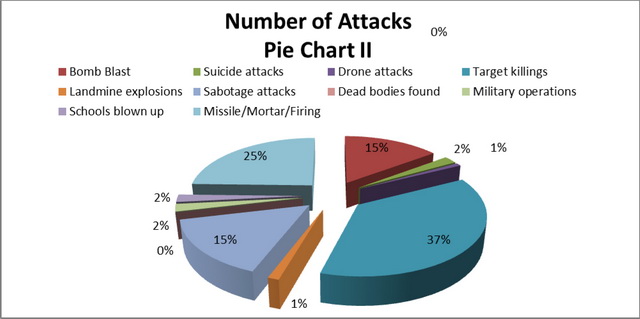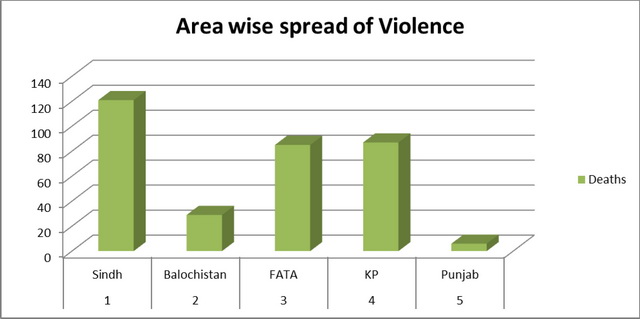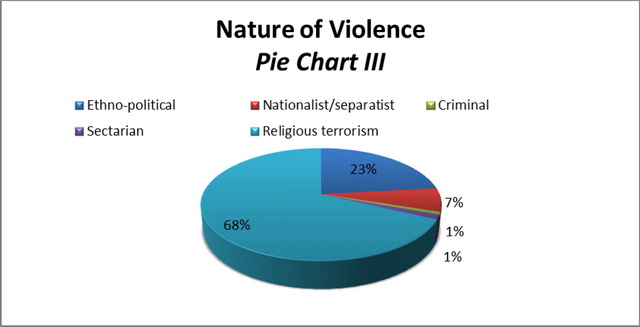April witnessed considerable up surge in violence across Pakistan. Ethno-political violence in Karachi, religio-terrorism in Federally Administered Tribal Areas (FATA) and Khyber Pakhtunkhwa (KP), and nationalist-separatist violence in Balochistan, meanwhile continued unabated. The deadly wave of target killing in Karachi, started in the last week of March 2013, continue to mount death toll during April. The deadly wave left almost 100 persons dead (due to target killing) during the current month. Most of the persons perished in Karachi during April in different circumstances. The data collected throughten newspapers that CRSS uses as the source, suggests that some 533 people lost their lives in 244 incidents of violence across the country (for details see data sheet). The violent clashes also left 520 people injured only in April.
A concise look into the casualty figures underlines that the civilians remained the major target of violent actors, as a result of various acts of violence and terror in Pakistan. As noted in pie chart I below, civilians were 46 per cent (64 percent in last month) of the total dead in April. As a whole 241 civilians were killed in different circumstances during the month. Moreover, the data suggests that the militants fighting against the state remained the second major target i.e. 38 percent (199) of the total dead. Clashes also left 80 security forces– personnel (16 percent of total deaths) dead and these were mostly recorded in insurgency infested areas of FATA, Karachi and Baluchistan. Furthermore, during April, two CIA operated drone strikes were reported in different areas of FATA, leaving as many as 13 suspected militants dead. Meanwhile, continuing their sabotage campaign to demolish state infrastructure, militants blew up five state run and private schools and 38 other sort of infrastructure in different parts of FATA, Baluchistan, Sindh and KP during the course of month.
In contrary to preceding months, in April again, shelling, firing and mortar attacks were the major cause of deaths. As a result of which, as many as 214 persons perished, including 20 civilians and 155 militants and 39 security forces personnel in different parts of the country. Meanwhile, target killing was the second major cause of deaths. Pie chart II below shows that 37 percent of all the violent incidents were of target killing in nature, accounting for 19 percent of the total death toll. Numerically 100 persons were shot dead across Pakistan, as a result of 90 incidents of target killing. Karachi witnessed the major loss of lives as a result of target killing, wherein 60 persons (60 percent of the total dead in target killings) assassinated during the month. The third major cause of the violence was bomb blasts. In total, 67 persons including 59 civilians and eight security personnel perished in this form of attacks. Meanwhile, in April, 42 dead bodies were also recovered from different parts of Pakistan, most of them, were found in Karachi, Peshawar, FATA and Balochistan. Likewise, five suicide attacks left 38 civilians dead.
A peer into the territory and intensity of violence underlines that Sindh witnessed major loss of lives during the current month (as shown in bar chart below). After Sindh, KP and FATA turned out to be the second major hub of violence, where religio-terrorism left almost 87 and 85 people respectively, dead during the current month. Meanwhile, violence across Balochistan subsided significantly during the course of the month.
Moreover, the sporadic waves of sectarian violence continued to pile up misery in Pakistan. In March seven people were killed in sectarian attacks; majority belonging to Shia minority sect, in different areas of Sindh and KP as a result of seven violent incidents. Of the total seven attacks, six attacks that is, 86 percent took place in Karachi alone killing six, 86 percent of the total dead in sectarian violence. Shia sect people based in Karachi are among the frequent targets of sectarian terrorists.
Meanwhile, data relating to the nature of violence suggests that almost 68 percent of the total loss of lives was the direct consequence of religio-terrorism. The epicenter of faith-based violence continues to be FATA and KP. Ethno-political violence involving political parties, meanwhile, led to the decimation of 23 percent of the total dead. While both nationalist-separatist violence in Balochistan, criminal activities in Punjab and sectarian violence across Pakistan accounted for almost nine percent of the total fatalities. Accumulative data of last seven months (September-April) shows that 4427 persons have perished across Pakistan as a result of the ongoing wave of violence. Among these, February 2013 was the most violent month.
A precise look into the trends and territory of violence across the country underscores that the law and order situation across Pakistan is not satisfactory. Yet a considerable increase in the death toll has been witnessed, in successive weeks, during April. Latest trends of violence are religio-political in nature due to surge in attacks on election campaign.
Sources
- The News
- Dawn
- The Express Tribune
- Pakistan Today
- Daily Times
- The Frontier Post
- Jang (Urdu)
- Daily Mashriq (Urdu)
- Aaj (Urdu)
- The Nation

